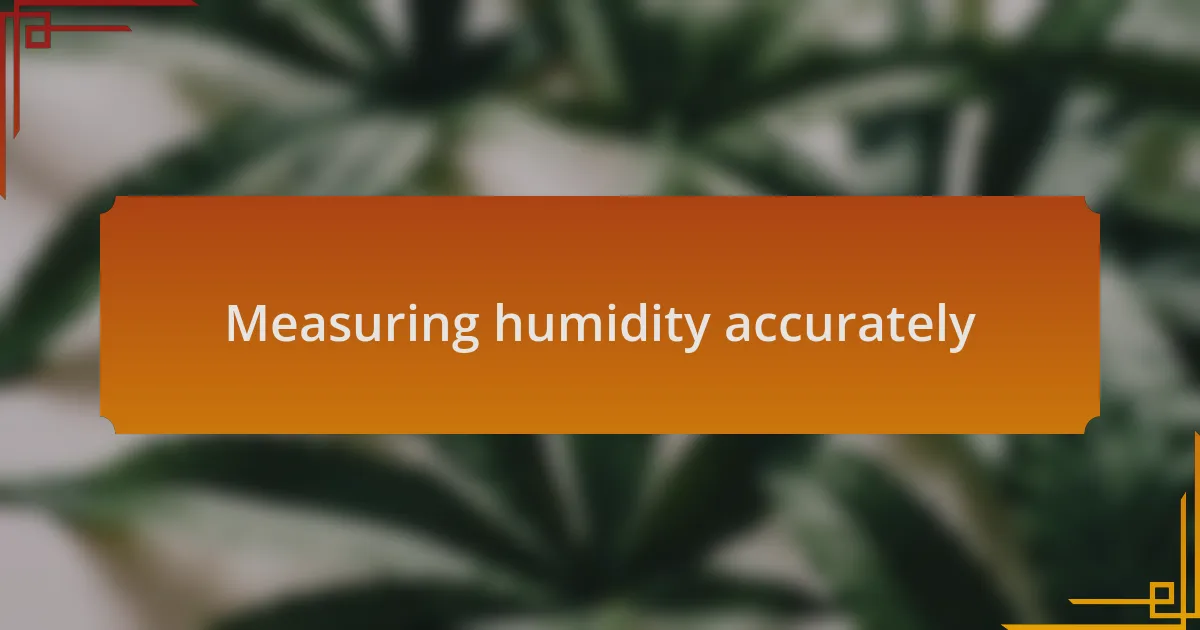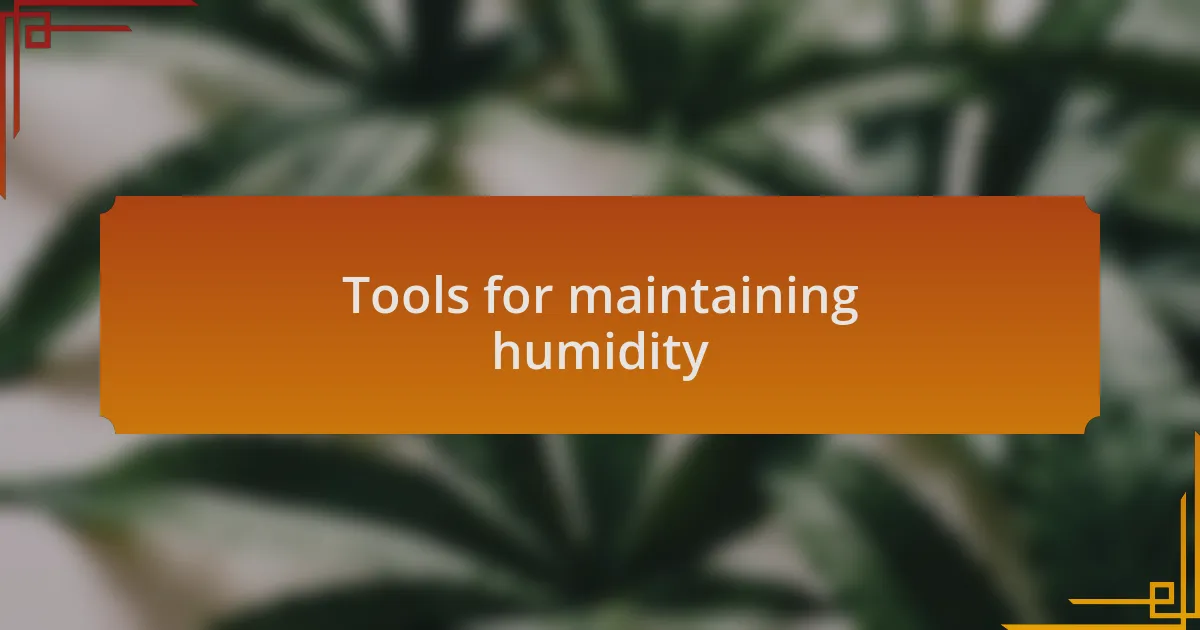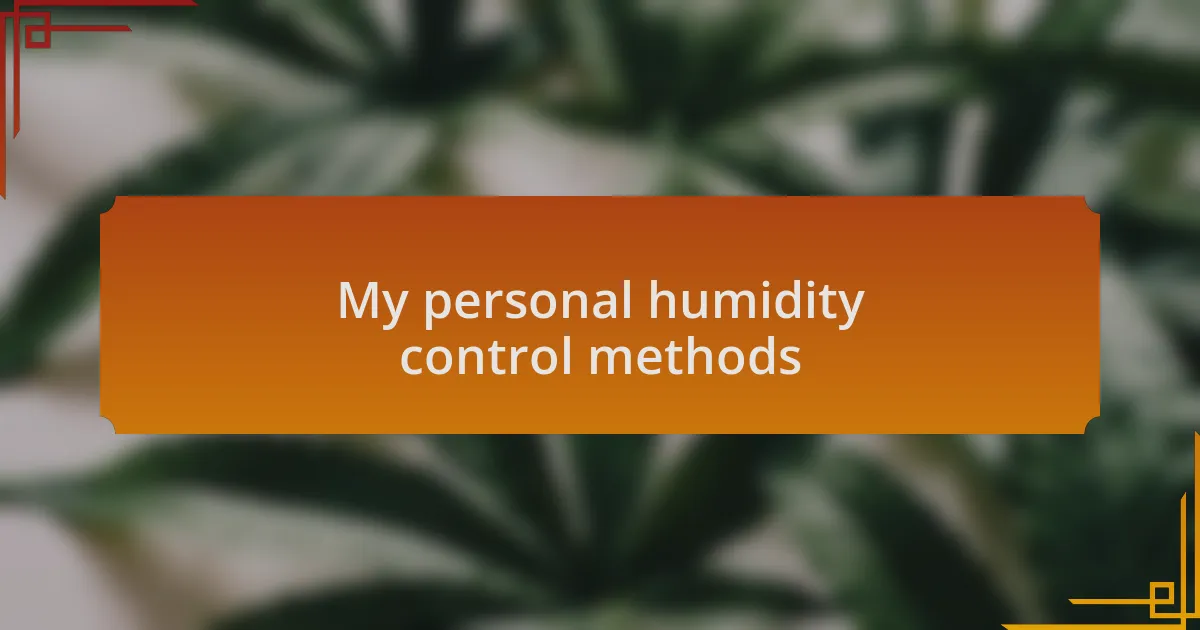Key takeaways:
- Maintaining optimal humidity is crucial for preventing mold and ensuring healthy cannabis growth, especially during the seedling and flowering phases.
- Regular monitoring with a hygrometer and appropriate calibration is essential to avoid fluctuations that can harm plants.
- Utilizing tools like humidifiers, dehumidifiers, and ventilation systems can significantly improve humidity control and plant health.
- Personal techniques such as using moisture-absorbing crystals and wet towels can enhance moisture regulation and maintain a balanced environment.

Understanding humidity in cannabis
Understanding humidity in cannabis is crucial, as it directly impacts the health and quality of the plants. I recall my first grow where I underestimated the significance of moisture levels—my plants suffered from mold due to high humidity, teaching me that maintaining optimal conditions is not just a recommendation but a necessity for success. How can we nurture our plants if we’re not mindful of their environment?
Humidity affects various stages of cannabis growth, particularly during the seedling and flowering phases. I remember the excitement I felt when transitioning to flowering, only to realize that my humidity levels were too high, causing the flowers to develop improperly. It’s fascinating to think how slight adjustments can mean the difference between a bountiful harvest and a disappointing one. Have you ever experienced that sense of dread when things aren’t going as planned?
Using a hygrometer to monitor humidity has become a ritual for me. Each time I glance at the display, I feel a sense of control and responsibility over my plants’ well-being. It’s about more than just numbers; it’s about cultivating an environment where cannabis can thrive. Isn’t it amazing how something as simple as humidity can unlock the full potential of our plants?

Importance of optimal humidity levels
Optimal humidity levels play a critical role in preventing issues like mold and mildew, which can devastate a cannabis crop. I vividly remember my first encounter with bud rot; I didn’t realize how quickly it could take hold under high moisture conditions. Have you ever lost a prized bud to rot? The frustration is entirely avoidable when we learn to balance humidity.
During the flowering stage, maintaining the right humidity not only enhances the terpenes but also supports the overall potency of the buds. I found that when I dialed in my humidity levels, the aroma from my plants transformed beautifully. Isn’t it amazing how slight adjustments in the environment can lead to such big changes in quality?
Another essential aspect is respiration; plants absorb CO2 and release moisture. When humidity is too high, this process is hindered, leading to weaker plants. There was a time when I overlooked this, and my plants showed stunted growth. It’s a reminder that every detail matters. How well do you know your plants’ needs? Recognizing their signals can significantly improve your grow.

Measuring humidity accurately
To measure humidity accurately, I always rely on a reliable hygrometer, which is a tool designed specifically for that purpose. I remember purchasing my first digital hygrometer and feeling a wave of relief when I saw the precise readings; it’s a game changer for maintaining optimal conditions. Have you ever experienced inaccurate readings that led to problems? Trust me, investing in a quality device is worth it.
Calibrating your hygrometer regularly is essential to ensure accuracy over time. I once made the mistake of assuming my device would maintain its precision indefinitely, only to discover fluctuating humidity levels that threw my plants into chaos. It’s intriguing how a tiny adjustment in calibration can have such a noticeable impact. Have you checked yours lately?
Reading humidity levels in different areas of your grow space can also provide invaluable insights. I like to take multiple readings to ensure that every corner has the right conditions. It’s fascinating to see how localized airflow or temperature variations can create microclimates, influencing plant health. Have you tapped into these nuances in your grow yet? Understanding the full picture is crucial for a successful harvest.

Tools for maintaining humidity
Maintaining the right humidity levels isn’t just about measuring; it’s also about controlling those levels with the right tools. I’ve found that using a quality humidifier can make a significant difference. When I got my first ultrasonic humidifier, it was like turning a dial on my grow environment. I was amazed at how easily I could maintain the desired humidity levels. Have you considered how a small investment in equipment could transform your growing experience?
On the other hand, dehumidifiers are equally essential, especially during those hotter months when excess moisture threatens the health of your plants. I learned this the hard way when I noticed signs of mold creeping in due to high humidity levels. Since then, I’ve made it a point to integrate a dehumidifier into my setup, and it’s given me peace of mind knowing I can combat that risk effectively. Have you taken steps to protect your plants from humidity-related issues?
Finally, don’t underestimate the power of ventilation tools like fans. When I added oscillating fans to my grow room, I was blown away by the improvement in air circulation. Proper airflow not only helps regulate humidity but also strengthens plant stems, promoting healthier growth. How do you handle air movement in your space? A well-ventilated environment can truly be a game changer in maintaining optimal humidity levels.

My personal humidity control methods
One method I swear by is regularly checking my hygrometer. I remember a time when I was too reliant on my humidifier without monitoring levels closely. Suddenly, my plants started drooping, and I quickly realized I had over-humidified the space. Now, I make it a habit to glance at my hygrometer every day—it’s like having a pulse on my grow environment. Have you ever experienced the panic of seeing your plants suffer due to humidity mismanagement?
In addition to monitoring, I’ve started using moisture-absorbing crystals in the soil. When I first discovered them, I was skeptical, but after seeing how they helped regulate water levels in my pots, I was sold. This little tweak has added an extra layer of stability to my humidity control that I didn’t expect. It has certainly fostered a more balanced ecosystem for my plants, and I’m curious if you’ve experimented with soil amendments to manage moisture?
Lastly, I like to employ a simple trick: wet towels placed around my grow area during dry spells. It might sound odd, but this method proved surprisingly effective for me. I recall a particularly dry summer where my indoor humidity dropped dangerously low. The wet towels not only added moisture but also brought a bit of nostalgia from my childhood playing in summer heat with damp rags. I often wonder, do you have any unconventional methods that have worked wonders in your experience?